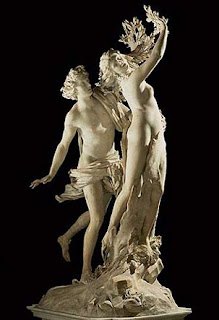Image courtesy of: http://www.storiadellarte.com/
Image courtesy of: http://acisandgalateaguide.blogspot.com/
Executed for Cardinal Scipione Borghese between 1622-1625, Gian-Lorenzo Bernini's masterwork, Apollo and Daphne, is a sublime execution in white Carrara marble depicting the flight of the sylvan nymph, Daphne, from the amorous clutches of the besotted Apollo.
Basing the work on Ovid’s poem, “Metamorphoses,” the young Bernini, still in his mid-twenties, worked for three years to complete it. It is the tale of the eternally youthful god of song and lyre, Apollo, and his unrequited first love for the wood-nymph, Daphne. As the tale is narrated in “Metamorphoses,” Apollo, catching Eros playing with his (the god’s) bow and arrows, arrogantly admonishes Venus’ mischievous son for doing so. In revenge for this taunting, guileful Eros fashions two arrows: he strikes the Delphic god with the first, piercing him in the breast with a sharp and refulgent, love-inducing golden arrow. Forthwith, Apollo espies the elusive and chaste Daphne, who had also been struck, but by the second of vengeful Eros’s arrows, one which is leaden and blunted, the kind which repels love.
Apollo is instantly enamoured with her and is determined to possess her. Repelled and unwilling to surrender to the ardent god, however, Daphne takes flight and Apollo gives chase. Like a terrified hare pursued by a relentless hound treading on its heels, flitting nimbly first this way and then that, she flees the godly pursuit: he impelled by fiery love and desire, she by panicked fear and repulsion. In mid-pursuit, fleet-footed Daphne invokes her father’s assistance, the river god Peneus, in escaping persistent Apollo’s capture.
Close-up of Daphne
Image are courtesy of: http://www.galleriaborghese.it/
The miracle of this sculpture is that Bernini managed to render in stone the precise moment when, hearing the desperate cry of his daughter’s imploration, Peneus answers her prayer by metamorphosing her into a laurel tree. The realism of this sculpture is taken to its ultimate limit.
Recommended readings:
Metamorphoses (2001), by Ovid (translation by Horace Gregory): Signet Classic
Bernini: The Sculptor of The Roman Baroque (1997), by Rudolf Wittkower: Phaidon Press











No comments:
Post a Comment